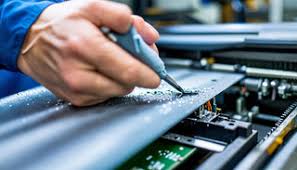What Is A DTF Printer, And How Does It Work?

In the fast-evolving world of textile printing, new technologies continue to reshape how businesses create high-quality designs on fabric. Among these innovations, the DTF printer has gained massive popularity because of its versatility, efficiency, and ability to deliver detailed prints with vibrant colors. Unlike traditional printing methods, DTF technology is changing how small businesses, large production houses, and even custom T-shirt shops approach garment decoration. But what exactly is a DTF printer, and how does it work? Let’s dive deep into the details.
What Is a DTF Printer:
A DTF (Direct-to-Film) printer is a digital printing device designed to transfer detailed designs onto a special PET (polyethylene terephthalate) film before being heat-pressed onto fabric. Unlike DTG (Direct-to-Garment) printing, where the design is directly printed onto the fabric, DTF uses a film intermediary. This makes it highly versatile, allowing prints not only on cotton but also on polyester, blends, denim, and even leather.
Essentially, a DTF printer combines the power of digital inkjet printing with transfer technology. This gives businesses the flexibility to print in bulk or on demand while maintaining superior color accuracy and long-lasting results.
How Does a DTF Printer Work:
The DTF printing process involves several steps, each crucial for ensuring high-quality, durable prints:
Step 1: Design Creation
The process begins with creating a design using graphic software like Photoshop, Illustrator, or CorelDRAW. This digital file is then prepared for printing with appropriate color adjustments.
Step 2: Printing on PET Film
The design is printed onto a PET transfer film using special pigment inks. DTF inks are water-based and formulated to deliver sharp details and vivid colors. White ink is typically used as a backing layer to ensure the design stands out on dark or colored fabrics.
Step 3: Powder Application
After printing, a fine layer of hot-melt adhesive powder is applied to the printed film while the ink is still wet. This powder sticks to the printed areas and will later act as the glue that bonds the design to the fabric.
Step 4: Curing
The film with adhesive powder is cured using a curing oven or heat press. This step melts the powder slightly, preparing it for the transfer stage.
Step 5: Heat Transfer
The cured film is placed onto the fabric, and a heat press applies pressure and high temperature (usually around 160–170°C for 15–20 seconds). This process fuses the ink and adhesive into the fibers of the fabric.
Step 6: Peeling and Finishing
Once cooled, the PET film is peeled off, leaving the design permanently bonded to the fabric. A post-press step can also be done to ensure a smoother finish and stronger durability.
Why Is DTF Printing So Popular:
DTF printers are quickly becoming the go-to solution for many apparel decorators. Here are a few reasons behind their growing popularity:
- Versatility: Works on cotton, polyester, silk, blends, and more.
- Vibrant Colors: Produces bright, detailed, and durable designs.
- No Pre-Treatment Needed: Unlike DTG printing, fabrics don’t need pre-treatment before printing.
- Cost-Effective for Small Runs: Ideal for custom orders or bulk production.
- Durability: Prints withstand washing, stretching, and daily wear.
For small business owners, hobbyists, and professional print shops, this technology bridges the gap between affordability and professional-grade results.
Comparing DTF With Other Printing Methods:
It’s natural to wonder how DTF compares with other popular garment printing technologies:
- DTG Printing: While DTG is excellent for cotton fabrics, it struggles with polyester or blends. DTF overcomes this limitation by working on almost all fabrics.
- Screen Printing: Screen printing is great for large batches but time-consuming and costly for small runs. DTF is better for quick, detailed, and multi-color designs.
- Sublimation Printing: Sublimation works best on polyester but cannot be used on cotton. DTF offers greater fabric flexibility.
This makes DTF an all-rounder solution, especially for businesses catering to varied customer demands.
Applications of DTF Printing:
DTF printers are widely used in industries like:
- Fashion and Apparel: Custom T-shirts, hoodies, denim, and activewear.
- Promotional Products: Bags, caps, and uniforms for branding.
- Home Textiles: Pillow covers, curtains, and upholstery.
- Personalized Gifts: Customized prints for birthdays, weddings, and events.
Whether you’re launching a clothing brand or simply offering personalized merchandise, DTF provides a practical and scalable solution.
Why Businesses Trust DTF Technology:
One reason why many entrepreneurs choose DTF is its ability to combine high-end printing quality with ease of use. Even beginners in textile printing can achieve professional results after some practice. Leading companies such as DTF LINKO have also contributed to the popularity of this technology by offering reliable, innovative machines and consumables that meet global standards.
Additionally, the reduced production cost per print makes DTF attractive for small businesses and startups aiming for high profit margins. With online customization trends booming, the demand for DTF-printed apparel is expected to grow significantly.
Final Thoughts:
A DTF printer is more than just a machine—it is a gateway to creativity and profitable opportunities in the textile industry. By allowing printing on multiple fabrics with vibrant, durable results, DTF technology offers unmatched flexibility for both small and large-scale operations.
If you’re considering starting a garment printing business or upgrading your current setup, investing in a DTF printer could be one of the smartest moves you make. Its efficiency, versatility, and high-quality output ensure that you’ll stay ahead in an increasingly competitive market.



